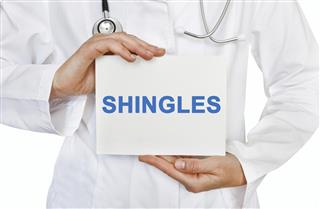
Shingles is a condition that is caused by the Varicella-Zoster Virus, which is also the causal agent for chickenpox. The following article provides information on this viral disease.
The United States reports nearly 1 million cases of shingles annually, and it is believed that 1 in 3 Americans go on to develop this condition at least once in their lifetime.
Shingles, which is also known as herpes zoster, is a medical condition characterized by the development of painful blisters on the skin. It is caused by the ‘Varicella-zoster Virus‘ (VZV), which is the virus that is responsible for causing chickenpox in humans.
When a person suffers from chickenpox during childhood, the VZV remains in the body lifelong even after the individual has fully recovered from chickenpox. The virus lies in a dormant form, until it gets reactivated. When it does, one is affected by shingles, and not chickenpox. For this reason, herpes zoster is also referred to as the revisiting chickenpox disease. The virus is likely to get reactivated if the person is under constant stress, or has a compromised immune system. While most of the symptoms of this condition are flu-like, there are some characteristic symptoms which help in the diagnosis of this condition.
The symptoms arise when the virus travels up the nerve roots that supply sensation to the skin on one side of the body, thereby causing inflammation. The main symptom is the development of small painful blisters on the individual’s skin, lined up like a strip or band, along the path of the nerve branch, or the area of skin supplied by those specific nerve roots. It is this distinctive symptom that usually helps the doctors to diagnose this condition. These blisters break and form small sores, which begin to dry and eventually form crusts. Later, the scabs crust in 2 to 3 weeks.
A few other symptoms include:
↪ Tingling sensation
↪ Fever and chills
↪ Sensitivity
↪ Itching
↪ Joint pain
↪ Malaise
↪ Headaches
↪ Swollen glands (lymph nodes)
The treatment involves the use of antiviral drugs for alleviating the symptoms and speeding up the recovery process. Timely medical assistance is also required to lower the risk of a complication called neuralgia, which develops when herpes zoster reaches the advanced stage. In order to avoid this, one has to be watchful and consult a physician the moment the symptoms are suspected. You should also seek a physician’s help if you continue to experience pain even after the rash has disappeared. If ignored, the condition can further worsen and lead to ‘postherpetic neuralgia’ – a condition characterized by unbearable pain.
If not treated in time, it can lead to severe health problems like:
↪ Loss of eyesight
↪ Pneumonia
↪ Malfunctioning of some organs
↪ Hearing problems
↪ Encephalitis (inflammation of the brain due to a virus)
The VZV virus that causes chickenpox and herpes zoster can spread when a healthy person comes in direct contact with the open wounds/rashes/blisters of an individual suffering from this disease. It must be noted that when the virus spreads to a person who has never had chickenpox in his entire life, it would cause chickenpox and not herpes zoster. Shingles affects only those who have had chickenpox earlier. It occurs when the dormant virus gets reactivated. The risk of transmission is high during the phase when the patient has developed blisters that have clear fluid, but the rash covering the blisters is yet to develop crusts. Simply put, the virus can be transmitted till the blisters have dried and formed crusts.
The risk of transmission is higher in case of people with a weak immune system, small children, or pregnant women, when compared to healthy individuals. However, it would be best to avoid any contact with an individual who is affected by this disease.
… an individual is in his old age, above 50 years.
… a person is suffering from a disease that weakens the immune system (AIDS and cancer).
… a person is taking immunosuppressive drugs.
Take a Note:
- The risk of transmission is high during the phase when blisters have developed, but the crusts are yet to form. Therefore, it is better to cover these blisters during this phase.
- You need to strictly follow the guidelines given by the doctor.
- You should avoid exposure to sunlight. Stay in a cool and dry room.
- Avoid scratching the area that is affected by rash.
Some individuals have reported pain without having any antecedent rashes. This is a very rare condition called zoster sine herpete (ZSH). Though the absence of obvious symptoms makes the diagnosis of this condition a bit difficult, it is extremely painful, with pain radiating along a single spinal nerve. Timely diagnosis and treatment is extremely essential to lower the risk of complications.
Disclaimer: This HealthHearty article is purely for informative purposes, and should not be treated as a replacement for professional medical advice.




